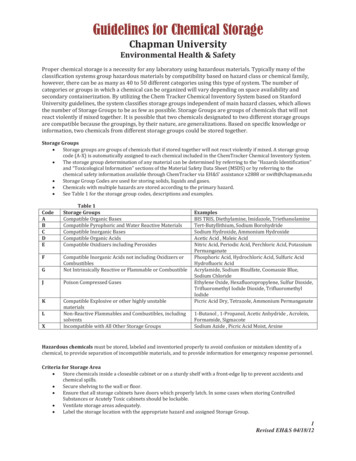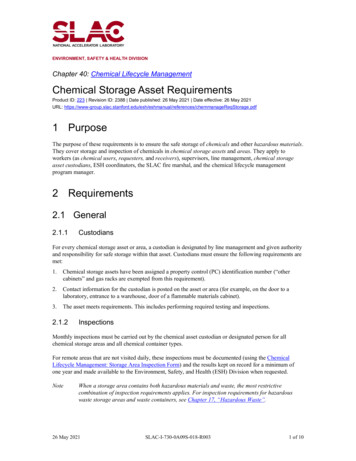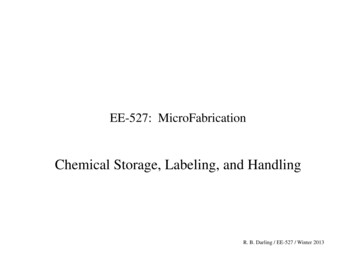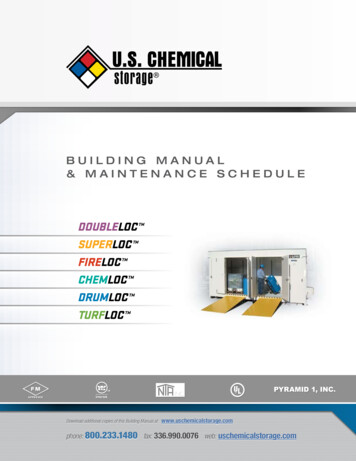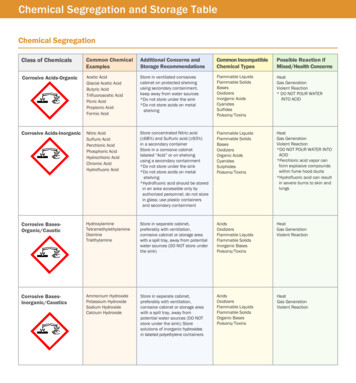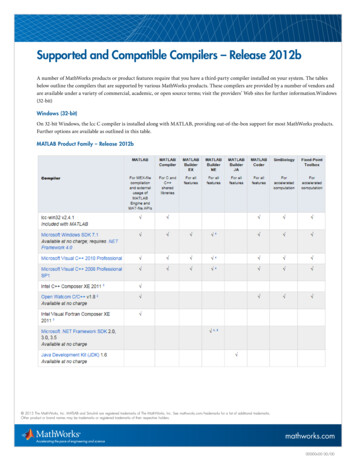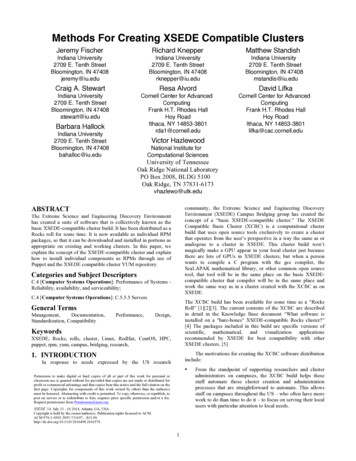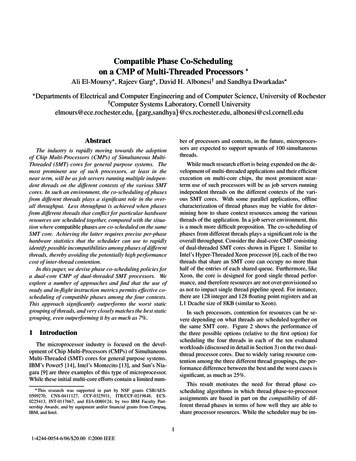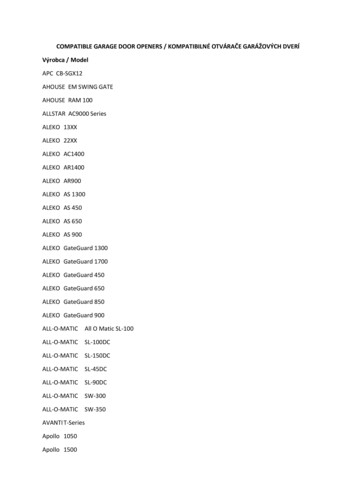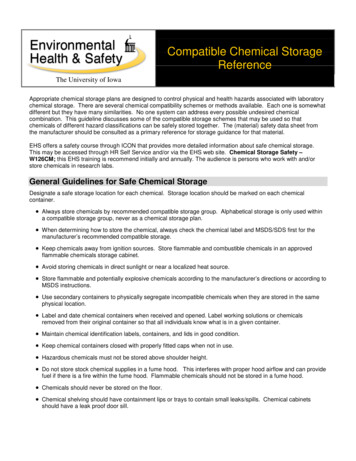
Transcription
Compatible Chemical StorageReferenceThe University of IowaAppropriate chemical storage plans are designed to control physical and health hazards associated with laboratorychemical storage. There are several chemical compatibility schemes or methods available. Each one is somewhatdifferent but they have many similarities. No one system can address every possible undesired chemicalcombination. This guideline discusses some of the compatible storage schemes that may be used so thatchemicals of different hazard classifications can be safely stored together. The (material) safety data sheet fromthe manufacturer should be consulted as a primary reference for storage guidance for that material.EHS offers a safety course through ICON that provides more detailed information about safe chemical storage.This may be accessed through HR Self Service and/or via the EHS web site. Chemical Storage Safety –W126CM; this EHS training is recommend initially and annually. The audience is persons who work with and/orstore chemicals in research labs.General Guidelines for Safe Chemical StorageDesignate a safe storage location for each chemical. Storage location should be marked on each chemicalcontainer. Always store chemicals by recommended compatible storage group. Alphabetical storage is only used withina compatible storage group, never as a chemical storage plan. When determining how to store the chemical, always check the chemical label and MSDS/SDS first for themanufacturer’s recommended compatible storage. Keep chemicals away from ignition sources. Store flammable and combustible chemicals in an approvedflammable chemicals storage cabinet. Avoid storing chemicals in direct sunlight or near a localized heat source. Store flammable and potentially explosive chemicals according to the manufacturer’s directions or according toMSDS instructions. Use secondary containers to physically segregate incompatible chemicals when they are stored in the samephysical location. Label and date chemical containers when received and opened. Label working solutions or chemicalsremoved from their original container so that all individuals know what is in a given container. Maintain chemical identification labels, containers, and lids in good condition. Keep chemical containers closed with properly fitted caps when not in use. Hazardous chemicals must not be stored above shoulder height. Do not store stock chemical supplies in a fume hood. This interferes with proper hood airflow and can providefuel if there is a fire within the fume hood. Flammable chemicals should not be stored in a fume hood. Chemicals should never be stored on the floor. Chemical shelving should have containment lips or trays to contain small leaks/spills. Chemical cabinetsshould have a leak proof door sill.
Shelving should be strong enough to hold the weight of chemicals being stored on them. Do not overloadshelves. Always secure shelving to a permanent structure. Shelves should be coated with a chemicalresistant material such as chemical-resistant paint or another coating such as epoxy. Do not store chemicals in a domestic refrigerator or walk-in cooler. These refrigeration devices contain ignitionsources such as unsealed electrical contacts. Flammable-safe refrigerators should be used wheneverflammable chemicals need to be refrigerated. Additionally, walk-in coolers are not vented, creating thepotential for accumulation of chemical vapors. Every 60 days, as stated in the DHS Chemicals of Interest reminder e-mail sent by EHS, check that yourdocumented chemical list matches your lab’s physical chemical inventory (or at least once a year if your labpurchases or uses few chemicals). At the time you perform your inventory, look for expired chemicals anddispose of them properly.Secondary Containment GuidelinesSecondary containment is recommended to segregate chemicals from other incompatiblechemicals within the same storage cabinet. Segregating incompatible chemicals usingsecondary containment is helpful when chemical storage space is limited. Secondarycontainment is also recommended when storing highly toxic materials to minimize exposureshould the primary container become damaged. For example, store liquid mercury inside alabeled unbreakable secondary container. Small containers of compatible chemicals maybe stored in a desiccator or other secure device. Secondary containers should becompatible with the chemicals stored in them. They should not corrode or degrade easily.Chemical Storage Groups and Code SystemsIt is important that you segregate hazardous materials according to Compatible Storage Groups. The storagegroups allow you to safely organize chemicals with different or multiple hazards. There are several appropriatechemical storage strategies that may be used. The first example below is a list of compatible groups developed byStanford University (ChemTracker) into which chemicals can be segregated.Examples of laboratory chemicals in the following Compatible Storage Groups are found on page 4 below.Compatible Storage Groups, Stanford University ChemTrackerAOrganic Bases, Flammables, and PoisonsBPyrophoric Materials and Water Reactive MaterialsCInorganic Bases, Oxidizers, and PoisonsDOrganic Acids, Flammables, and PoisonsEOxidizers, Organic Peroxides, and AcidsFInorganic Acids not including Oxidizers and CombustiblesGNot Intrinsically Reactive or Flammable or CombustibleJPoison Compressed Gasses, not Flammable or ReactiveKCompatible Explosives or Other Highly Unstable MaterialLNon-Reactive Flammable and Combustible Materials,including SolventsXIncompatible with all other storage groups
Another system of compatible storage groups consists of nine chemical categories. In this plan there are ninestorage groups. Seven of these groups cover storage of liquids because of the wide variety of hazards posed bythese chemicals. Specific instructions must be followed for metal hydrides (Group VIII) and certain individualcompounds, but otherwise, dry solids are in Group IX. Many liquid chemicals pose hazards that correspond to morethan one storage group. These chemicals should be stored in the lowest group number.Compatible Storage Groups, Fred Hutchinson Cancer Research CenterGroup IGroup IIGroup IIIGroup IVGroup VGroup VIGroup VIIGroup VIIIGroup IXFlammable LiquidsPoisons - volatileAcids - OxidizingAcids - Organic and MineralBases - LiquidOxidizer - LiquidPoisons - Non-volatileReactivesSolidsAdditional information about this storage group system including 2 storage plan illustrations can be foundon the EHS web site in the document “Chemical Storage: Nine Compatible Storage Group System”.General Summary of SeveralManufacturer’s Chemical Storage Code SystemsHazardFlammablesHealth Hazards/ToxinsReactives/OxidizersContact HazardsGeneral StorageColor CodeRedBlueYellowWhiteGray, Green, OrangeIsolate SeparatelyStripeOther systems include manufacturer storage code systems on product labels. For example, Fisher has thefollowing colored storage group codes on chemical labels: Red flammable storage Blue health hazard; store in secure area Yellow reactive and oxidizing agents; may react violently with air, water, or other substance; store awayfrom flammables and combustibles White corrosive; store away from red-, yellow-, and blue- coded reagents, Gray general chemical storage).Mallinckrodt/J.T. Baker/Macron also has a color code system: Blue store in secure poison area Red store in flammable liquid storage Yellow store separately and away from flammables or combustibles White store in corrosion-proof area Green/formerly orange general storage area Striped indicates incompatible with other materials in the same color class; assess individual storage
Examples of Chemicals in the Compatible Storage Groups, Stanford University ChemTrackerGroup A – Compatible Organic Bases ine (DAB)Group D – Compatible OrganicAcidsButyric acidCitric acid monohydrateFormic acidGlacial acetic acid (also - storewith flammables if segregated)4-Morpholinepropanesulfonicacid (MOPS buffer)Propionic acid Group C – Compatible Inorganic Bases Ammonium hydroxide Potassium hydroxide Sodium hydroxide solutionsGroup E – Compatible Oxidizersincluding Peroxides Ammonium nitrateAmmonium perchlorateAmmonium persulfateBenzoyl peroxide, wettert-Butyl hydroperoxideCalcium hypochloriteChlorosulfonic acidChromic acidFuming nitric acidHydrogen peroxide, 30%Isoamyl nitritePotassium chloratePotassium dichromatePotassium permanganateSilver nitriteSodium chlorateSodium chloriteSodium hypochlorite solution(bleach)Group G – Not Intrinsically Reactiveor Flammable or Combustible(solids, store separately aboveliquids) Acrylamide, bis-acrylamideAgaroseAmmonium thiosulfateChloroquine diphosphateCoomassie brilliant blueDextroseDithiothreitolGuanidine hydrochlorideMagnesium chlorideMethotrexateSodium citrateSodium phosphate, monobasicPotassium chloridePotassium ferricyanideX-Gal roup F – Compatible InorganicAcids not including Oxidizers orCombustibles Hydrochloric acidNitric acidPhosphoric acidSulfuric acidGroup L – Non-Reactive Flammables and Combustibles, includingSolvents AlcoholsAcetaldehydeAcetoneAcetonitrileAmyl acetateBenzeneCarbon disulfideCyclohexaneDichloromethaneDiethyl pyrocarbonateDimethylformamideDimethyl sulfateDimethylsulfoxide (DMSO)DioxaneEthyl etherEthyl acetate Formaldehyde, 37%FormamideHexaneHydrazineIsoamyl alcoholβ-MercaptoethanolMethyl ethyl ketoneMethylene chlorideParaformaldehyde solidPhenolPiperidinePropanolSodium dodecyl sulfate(SDS) Tetrahydrofuran Toluene XylenesGroup G – Not Intrinsically Reactive or Flammable or Combustible(liquids) Chloroform IsofluraneNon-reactive chlorinated solvents may be stored with flammables.
Group X – Incompatible with ALLother storage groups Sodium azide Picric acid 10-40% waterGroup B – Compatible Pyrophoricand Water Reactive Materials Acetyl chlorideLithium aluminum hydride,other metal hydridesPhosphorus pentachlorideSilanes such as Silane gas,DimethyldichlorosilaneSodiumSodium hydrideToluene 2,6-diisocyanateExamples Compressed Gases andtheir respective CT CompatibleStorage Group Ammonia (C) Arsine (X) Carbon monoxide (L) Chlorine (E) Cyanogen chloride (J poison) Fluorine (E) Formaldehyde gas (L) Hydrogen (L) Hydrogen chloride (F) Hydrogen cyanide (C) Hydrogen sulfide (L) Nitric oxide (E) Ozone (E) Phospine (B) Silane (B) Stibine (B) Sulfur tetrafluoride (B) Tellurium hexafluoride (J poison)Examples of Group K – Compatible Explosive or other highly UnstableMaterials Ammonium picrate, dryBenzoyl peroxide, 97%DinitrophenolMercury fulminateNitroglycerinPicric acid, dryTrinitrotoluene (TNT)
Another more detailed chemical mixing compatibility chart is also available. It is based on a source from the Environmental Protection Agency. At the link, you willopen an Excel file that appears similar to the image below. Because this chart has numerous categories, it can be referenced to help form a better decision aboutthe storage category of a particular chemical when more information is needed.Chemical Mixing Compatibility ChartReactivity Reactivity Group NameGroup No.1Acids, Mineral, Non-Oxidizing2Acids, Mineral, Oxidizing3Acids, Organic4Alcohols and Glycols5Aldehydes6Amides78Chemical Mixing Compatibility Chart1[to assist with safe chemical segregation]2Modified From:G, H3HH, FH, PH, PH, FH, PH,GTHH,Amines, Aliphatic and AromaticGTAzo Compounds, Diazo Compounds H, G H,GTand arbamates13Esters14Ethers15Fluorides, Inorganic16Hydrocarbons, Aromatic17Halogenated Organics18Isocyanates19KetonesSource: EPA-600/2-80-076 / April 19804HH, G H,GTHHGT,GFH,GF, FHGT,GFH,GF, FH, FHH, FGTGTA Method for Determining the Compatibility of Chemical MixturesReactivity CodeConsequenceand from University of ArizonaHHeat GenerationFFireGInnocuous and Non-Flammable Gas GenerationGTToxic Gas GenerationGFFlammable Gas GenerationEExplosionPViolent Polymerization56HH7H, G H, G H8G, HHHGT,GFH,GF,9H, G10GGF,GTU11H, G12H, GH2021222324Mercaptans and Other OrganicS ulfidesMetals, Alkali and Alkaline Earth,ElementalMetals, Other Elemental Alloys asPowders, Vapors, or S pongesMetals, Other Elemental Alloys asS heets, Rods, Moldings, Etc.Metals and Metal Compounds,Toxic15GF,GTH,GT, FGF,H, FGF,H, FGF,H, FGF,H, FGF,H, FSGF,H, FSGF,H, FH,GT,H, F, GF,EHGT, HH, FGT,H, FH, F26Nitriles27Nitro Compounds, Organic28Hydrocarbons, Aliphatic,Unsaturated29Hydrocarbons, Aliphatic, S aturated30Peroxides and Hydroperoxides,Organic31Phenols and Cresols32Organophosphates,Phosphothioates, GT,HPhosphodithioates33S ulfides, Inorganic34Epoxides35Combustible and FlammableMaterials, Miscellaneous36Explosives37Polymerizable Compounds38Oxidizing Agents, S trong39Reducing Agents, S trong40Water and Mixtures ContainingWater41Water Reactive S ubstancesHExample16HNitridesMay be Hazardous But Unknown14GTH,GT, PH,H, G H, PGT, PH, F25Solubilization of Toxic SubstanceU13H, FH,GTH,GSH,GTH, PH, GH, GF HH, GH, P,GHH, GH, GUGF,H, FGF,H, FGF,HGF,HGF,HGT,H, F19GF, H GF, H GF, H GF.GF, HGT. HUGF, HSHHHH, EGF, H2021H, F,GSGF, H,F22H, FSHeat Generation, Fire, and Toxic Gas Generation18HH, GGF,H, FGFH,F,GT1723SGF, GF,H, E HUH, GH24UGF, H GF, H GF, HGF, H UGF, H GF, H E25UH, PH, EGF, H,EHSGF, H26GF, H,E27H, E28H, F29H, G H, EHGT,GFH, PH, FH, GGT,HH, F, GT, H,EFH, FH, GGT,HUGT,H, FH, PGTH, PHH, PGT, H, GT, H,EFH, EH. PGT, H, H, EFH, PH, PH, PH, EP, HP, HP, HP, HGT,HGF,HH, FH, FGF,H, FGF,H, FGT,H, FGF,HGT,H, FGF,HGF, H, GT, H,EPH, P30GH, HHH, PH, E GT, H,FG, HUH, PUGT, H, GT, H, H, FFFGT, H H, FH, FH, FH, PH, PH, PH, GH, PH, PGF, H,FGT, H,F33H, PUH, P34H, E35H, EH, EH, EEEH, EH, EH, EP, HP, HP, HP, HP, HP, HP, HP, HH, GH, FH, EGf,
Appropriate chemical storage plans are designed to control physical and health hazards associated with laboratory chemical storage. There are several chemical compatibility schemes or methods available. Each one is somewhat different but they have many similarities. No one system can address every possible undesired chemical combination. This guideline discusses some of the compatible storage .
